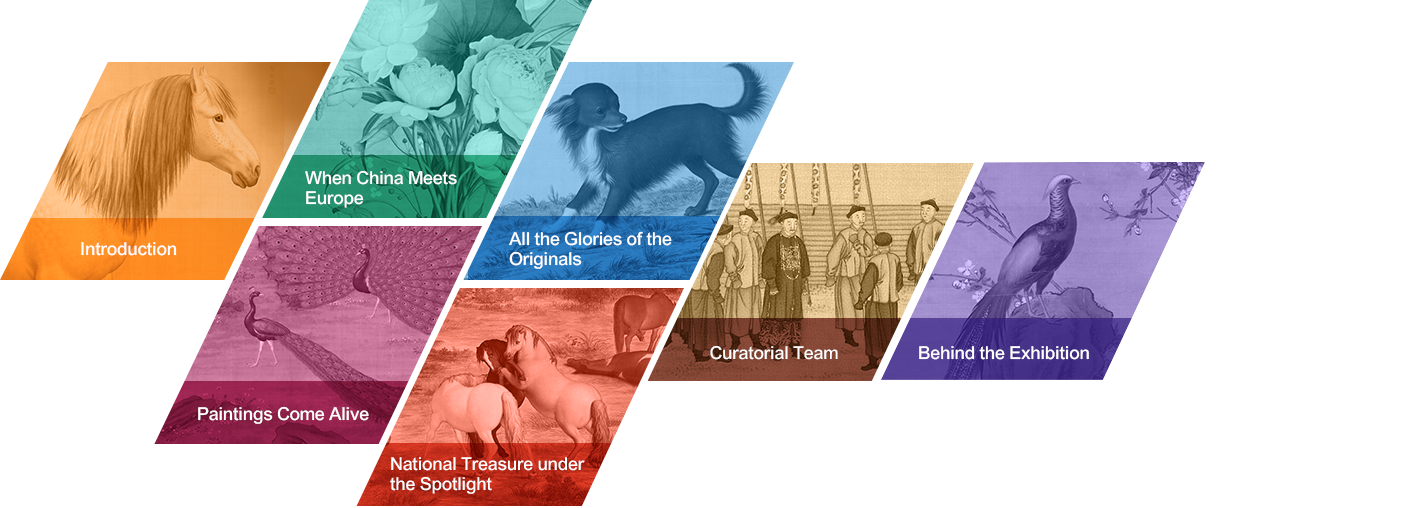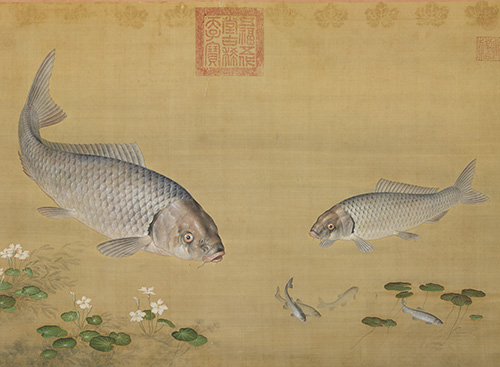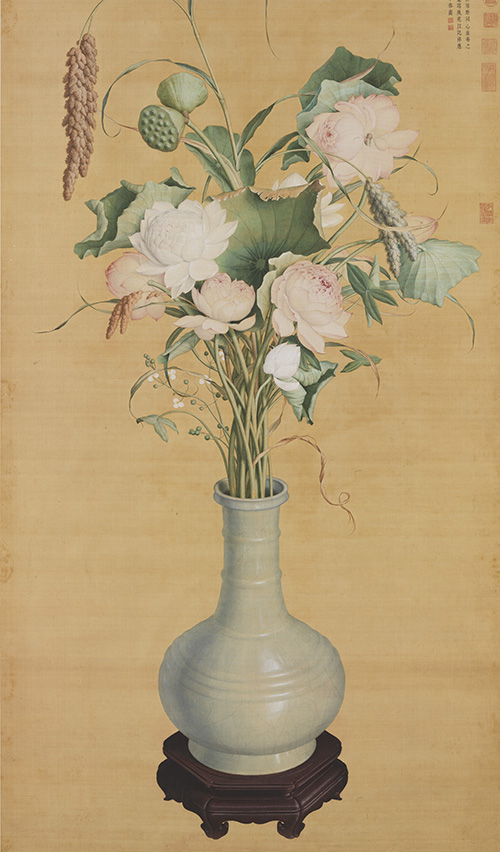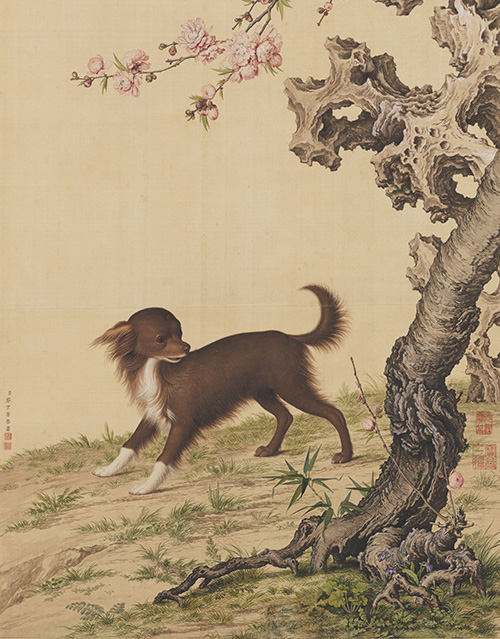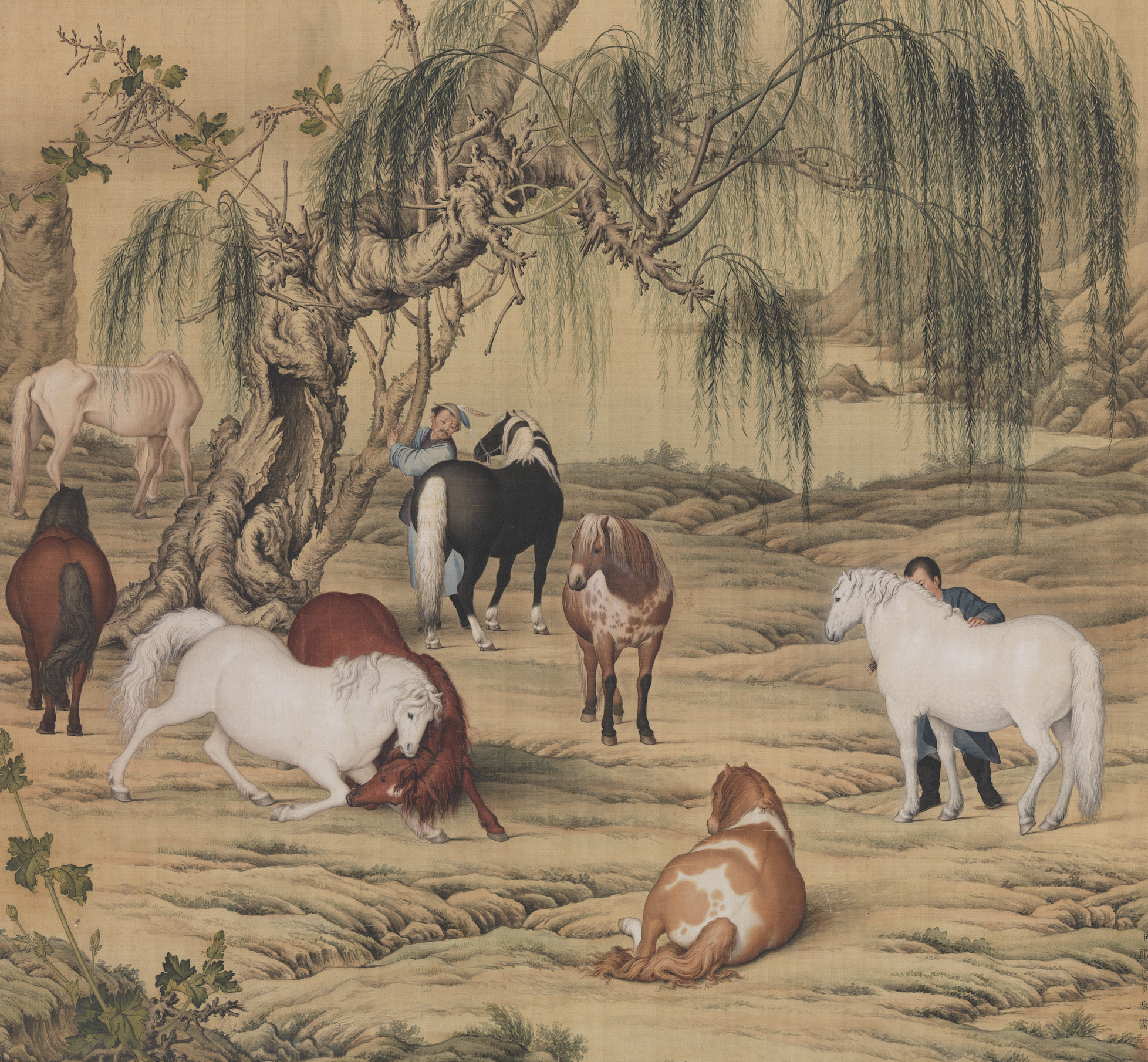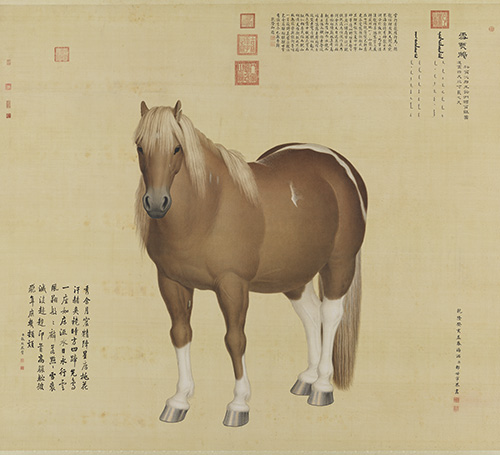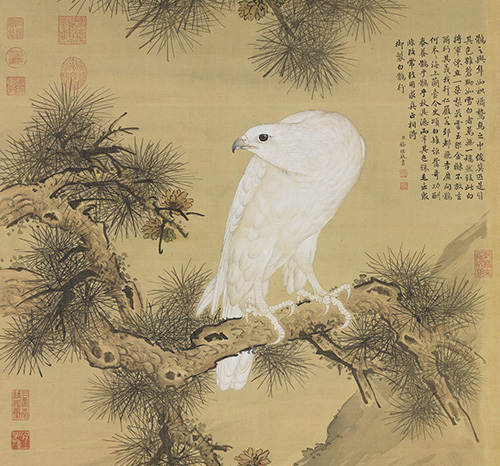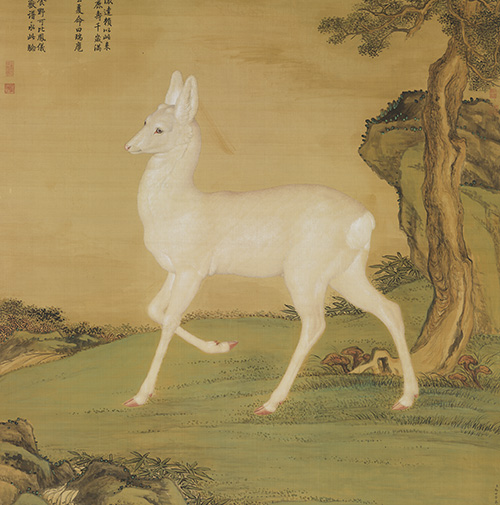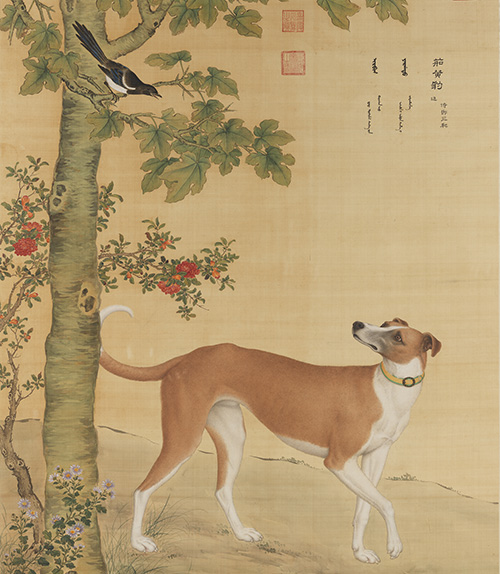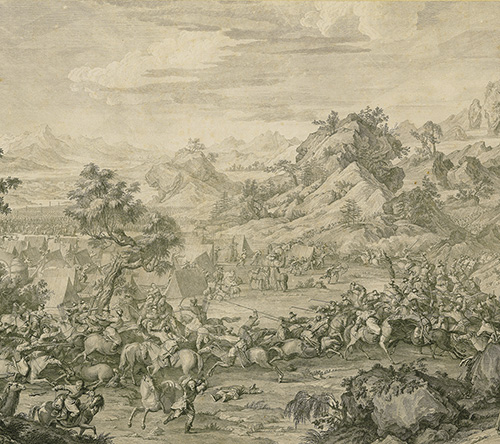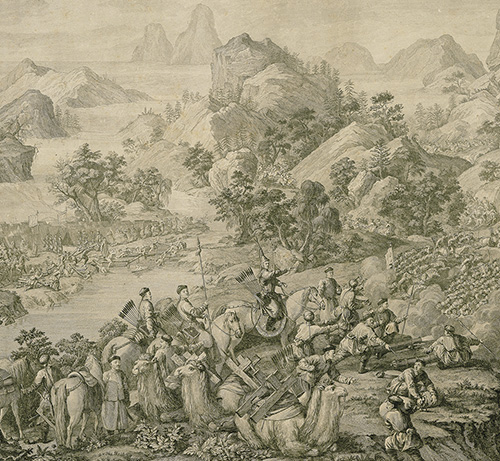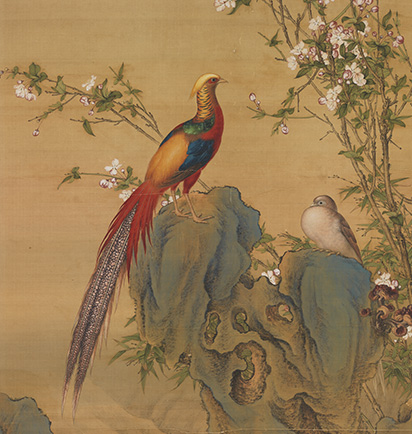Giuseppe Castiglione was a master of painting by his portraits, landscapes, animals and plants. Dogs and horses painted by him were especially praised. Not only did he use perspectives and shadows to bring his subjects to life, but he also used science to assist his art to reach a higher level of aesthetics. Several high-quality replicas of his paintings are displayed here to bring Castiglione's extraordinary skills for everyone to appreciate.
Lang Shining (Giuseppe Castiglione, 1688-1766), Qing dynasty
Fish and Aquatic Plants
- Hanging scroll, ink and colors on silk
- 68.8 × 122.1 cm
This painting depicts fish swimming in a pond. Here the subject and composition are based largely on Chinese models, but the realistic Western techniques emphasize shadows and volume instead, fully expressing the three-dimensional effect of the tails and fins of the fish. The addition of white pigment also makes their skin and scales appear quite glossy. The upper edge of the painting still re-tains traces of a leaf pattern, suggesting it might have originally been part of a framed wall painting in a palace hall that was later remounted into the hanging scroll seen here.
Lang Shining (Giuseppe Castiglione, 1688-1766), Qing dynasty
Gathering of Auspicious Signs
- Hanging scroll, ink and colors on silk
- 173 x 86.1 cm
In this painting is a celadon vase with an arrangement of auspicious plants such as dual-blossom lotuses and stalks of rice with two ears of grain, plants that have been used in painting since the Song and Yuan dynasties to symbolize sagacious rule. Giuseppe Castiglione signed his name in Chinese with the"Song-script" style of Qing court publications and included a date equivalent to 1723, the first year of the Yongzheng emperor's reign, making it his earliest dated work. An elevated point of view has been taken, allowing the viewer to peer into the neck of the vessel. Castiglione also used white pigment to highlight the shine on the glaze, enhancing the volumetric effect of this porcelain vase. As for the plants, Castiglione excelled at rendering gradated areas of color to express three-dimensionality and shading with a single source of light. The coloring overall is exceptionally refined, making the motifs appear as if radiating with brightness. The painting is a masterful example of how Castiglione translated Chinese subject matter using Western techniques. The vase shown here also appears similar to an imitation Ru-ware celadon with linear patterns in the collection of the National Palace Museum.
Lang Shining (Giuseppe Castiglione, 1688-1766), Qing dynasty
Long-haired Dog Beneath Blossoms
- Hanging scroll, ink and colors on silk
- 123.2 x 61.9 cm
This painting depicts a small reddish-brown dog by a lake rock and peach blossoms in a garden setting. The blossoms come from an old peach tree growing in the lower right corner and extending out of the composition. Even a few new sprigs with blossoms emerge from the dense and gnarled roots, suggesting that the tree is still full of life. In the background is a large decorative lake rock, its convoluted form complementing that of the old tree. The rendering of the little dog is quite precise and endearing, a sense of motion inherent in it despite the stillness. In mid-step, its attention appears to have been caught by something outside the composition, making it stop to look back. Giuseppe Castiglione used extraordinary refinement and realistic techniques to portray the animal, conveying not only its three-dimensionality but also the luster of its hair. Capturing both the subtleties of formal likeness and inner spirit, the latter became an especially important criterion for determining the success of an animal painting. This work is undated, but according to Qing court archives, Castiglione made alterations in the second lunar month of Yongzheng's fifth year (1727) to a painting of a small"date-red" dog, most likely referring to the one here.
Lang Shining (Giuseppe Castiglione, 1688-1766), Qing dynasty
Eight Horses
- Hanging scroll, ink and colors on silk
- 139.3 × 80.2 cm
Although this work was done with traditional Chinese painting materials, the representation of the horses, figures, and willow tree reveal the use of shading techniques found in Western art, thereby giving it a sense of realism. Two grooms take care of eight horses here in a lush and misty setting. Castiglione's signature in the lower right was done in fine Sung-style script, which indicates it was probably done not long after he arrived in China in 1715 and thus done sometime during the reign of the Yongzheng Emperor (r. 1723-1735).
Lang Shining (Giuseppe Castiglione, 1688-1766), Qing dynasty
Ten Steeds ("Snow-Flake Eagle")
- Hanging scroll, ink and colors on silk
- 238.2 × 270.6 cm
The steed depicted in this painting was presented as tribute to the Qing court in the eighth year of Qianlong’s reign (1743) by the chieftain No-mun E’ehetü (1672-1750) of the Mongol Horqin tribe. The Horqin tribe was the earliest to submit to the Qing court and formed a political marriage alliance with the imperial family, the two developing close ties. Giuseppe Castiglione was ordered to portray from life the fine steeds presented by distant peoples as a way to display the prestige of the Great Qing Empire.
As opposed to the traditional method of outlining forms with ink, Castiglione here used short strokes of ink and color to gradually build up layers of gradated hues that delicately portray the luster and texture of the horse’s hair and body, accurately conveying everything from the muscles and tendons of its legs to even the blood vessels under its skin.
Lang Shining (Giuseppe Castiglione, 1688-1766), Qing dynasty
White Bird of Prey
- Hanging scroll, ink and colors on silk
- 123.8 × 65.3 cm
In the sixteenth year of the Qianlong emperor’s reign (1751), the high court official Fuheng (1720-1770) presented this white bird of prey as tribute, and Giuseppe Castiglione was ordered to paint it from life, the pine tree and landscape with a waterfall added by another court artist. The branch of an old pine tree extends across the composition with a white bird of prey (falcon) perched on it, a cascade descending into the valley behind. The falcon with its short flat head peers out, its eyes sparkling black. It also has a pointed beak and muscular legs with sharp talons. The ruling Manchu at the Qing court often received birds of prey as tribute, reflecting the common interests and heritage they shared with northern nomadic peoples.
Lang Shining (Giuseppe Castiglione, 1688-1766), Qing dynasty
Auspicious Roe Deer
- Hanging scroll, ink and colors on silk
- 216.2 × 144.6 cm
In the autumn of 1751, the Qianlong emperor accompanied Empress Dowager Chongqing on a tour of the summer mountain retreat. Qianlong also traveled to the Mulan hunting grounds, where he was entertained to a banquet by Mongolian nobility. The Mongol Taiyiji presented a roe deer as an offering, its fur as white as snow and eyes sparkling red. According to Ge Hong’s (283-343) Baopuzi, the deer has a lifespan of a thousand years, turning white after reaching the age of 500. In this painting, the white roe deer has large ears and eyes, a long neck, and a short tail, serving as a symbol of good fortune and nobility as well.
Lang Shining (Giuseppe Castiglione, 1688-1766), Qing dynasty
Ten Fine Hounds (“Tawny-Yellow Leopard")
- Hanging scroll, ink and colors on paper
- 247.5 × 163.7 cm
In 1747, Giuseppe Castiglione is recorded as being ordered to do ten paintings of fine hounds, which probably corresponds to this series in the National Palace Museum collection. The dogs appear like portraits, the paintings bearing inscriptions in Chinese, Manchu, and Mongolian with their names and who presented them as tribute. “Tawny-Yellow Leopard,” the hound shown in this painting, was presented by Vice Minister Sanhe (?-1773). The dog looks back at a magpie screeching from a paulownia tree above. Pomegranate and chrysanthemum blossoms also embellish the scene. The dog’s gentle eyes and pleasingly lustrous hair make it appear quite lifelike.
Lang Shining (Giuseppe Castiglione, 1688-1766), Qing dynasty
Ayusi Sweeping Bandits with a Lance
- Hanging scroll, ink and colors on paper
- 27.1 × 104.4cm
Ayusi (birth and death dates unknown) was a Mongol Dzungar who submitted to and later fought for the Qing court. In the twentieth year of Qianlong's reign (1755), the Dzungar Khan Dawachi colluded with Tsarist Russia and in a pincher attack by Qing forces, he was forced to flee to Gädän-Ola, where he put up stubborn resistance. While there, Ayusi led a nighttime cavalry raid on the Dzungar rebel camp, scattering them. Though Dawachi managed to escape, he was captured later by Khojis. Ayusi was commended for his merits in battle and Giuseppe Castiglione ordered to do an oil portrait and a large painting of"Victory at the Military Camp." Ayusi's portrait was also transferred to this handscroll painting of him racing on horseback with a lance, arrows, and a rifle.
Here, Castiglione has completely done away with the background, realistically portraying Ayusi wearing a peacock-feather warming cap, an overcoat to protect against arrows, and a musket slung over his shoulder. With a bag of arrows at his waist, he holds onto reins with one hand and a lance with the other, leading his horse against the enemy.
Copperplate engraving of the "Storming of the Camp at Gädän-Ola" from the Victory in the Pacification of Dzungars and Muslims
Finalized in 1769 at Paris
- Drafted by Lang Shining (Giuseppe Castiglione), 1688-1766
Directed by Charles-Nicolas Cochin, 1715-1790
Engraved by J. Ph. Le Bas, 1707-1783 - 58 x 95cm
Also known as “Kalmuk Ayūsi Attacking Dawaachi’s Camp on Mount Gädän,” this illustration depicts a decisive battle where the Qing army defeated the Dzungars and gained control over the northern marches of the Tianshan Mountain. The historical account goes that one night in the late spring of 1755, General Ayūsi (n.d.), who was a former enemy surrendered to Qing, took twenty two horsemen to launch a surprise attack against the main camp of Dawaachi (?-1759), the Dzungar rebel leader. In this illustration, we can see Dawaachi’s camp at Gädän-Ola was heavily defended and equipped with several cannons. Ayūsi approached the enemy camp from a hidden trail. However, he was found by the enemy. All of a sudden, Ayūsi charged into the enemy camp with a lance, followed by his horsemen. He bravely entered enemy territory without any fear. Dawaachi’s soldiers were taken by surprise, and so scared that they ran into each other.
This illustration was drafted by Giuseppe Castiglione (1688-1766), who rendered the scene on the battlefield rather realistically. By finely presenting the human figures’ facial expressions and emphasizing spatial depth, the viewer can easily feel the sense of danger of the campaigns and the tension of men against men. We can see Ayūsi, riding a black horse with a lance in hand, stabbed his weapon into an enemy’s chest. After the end of the battle, Emperor Qianlong not only commissioned Giuseppe Castiglione to paint Ayūsi Scattering Rebels with Upraised Spear, but also wrote a poem to tell the story and praised his loyalty and bravery.
Having been drafted by Castiglione, the sketch was sent to Paris for engraving in 1775. The project was directed by the famed engraver Charles-Nicolas Cochin (1715-1790), and the craftsman assigned to the task, Jacques Philippe Le Bas (1707-1783), was then already a master artisan. His name is engraved on a rock at the lower part of the illustration. In 1779 the engraving was completed, and the prints were shipped back to China by the French East India Company the following autumn.
Copperplate engraving of the "Lifting of the Siege at the Black Water River" from the Victory in the Pacification of Dzungars and Muslims
- Drafted by Lang Shining (Giuseppe Castiglione), 1688-1766
Directed by Charles-Nicolas Cochin, 1715-1790
Engraved by J. Ph. Le Bas, 1707-1783 - Finalized in 1771 at Paris
- 58 x 95cm
The hardship and difficulties experienced by the Qing army can be inferred from the densely layered mountains and clouds in the background. The Qing’s fortification is on the left side. General Zhaohui, holding his horsewhip high in the air, is placed at the center. Calm and collected, he is in full armor and directs the soldiers with confidence. His fortitude and persistence under pressure seem to have the power to keep his soldiers on an even keel, and to boost their morale. On the right side, the reinforcement forces coming to the rescue launch attacks against the rebels from various fronts. While the various parts of the illustration were drawn separately in different times, they were seamlessly patched together, attesting to Castiglione’s dexterity in illustrating battlefield scenes. It is also an authentic and vivid record of the Qing army’s defeat of the rebels.
The sketch was sent to France for engraving by the master engraver Jacques Philippe Le Bas. The engraving was finished in 1771, and the copperplate and the prints were shipped back to China the next year.
Lang Shining (Giuseppe Castiglione, 1688-1766), Qing dynasty
Golden Pheasants in Spring
- Hanging scroll, ink and colors on silk
- 169.2 × 95.2 cm
This scroll portrays Chinese flowering crab apple in full bloom with a pair of golden pheasants (one male and the other female) perched on garden lake rocks by flowing water. The flowers form a brocade with exotic birds, auspicious spirit fungus, and bamboo all being metaphors to convey good fortune and longevity. The golden pheasant cock is shown with its bright and beautiful plumage, Giuseppe Castiglione using white lines to highlight the shine on its feathers for rich luster but without shadows for its form. The crab apple blossoms and spirit fungus are painstakingly colored with variations of light and dark as well. The landscape is rendered more with the Chinese use of brush and ink, but with exceptional attention paid to the detail. Even overlapping crab apple blossoms and bamboo in the background can be distinguished through the holes in the rock. The composition of this scroll is also more complex than that seen in"Myriad Longevity in an Everlasting Spring," indicating that the landscape is no longer merely a background for plants or animals.
Lang Shining (Giuseppe Castiglione, 1688-1766), Qing dynasty
Fish and Aquatic Plants
- Hanging scroll, ink and colors on silk
- 68.8 × 122.1 cm
This painting depicts fish swimming in a pond. Here the subject and composition are based largely on Chinese models, but the realistic Western techniques emphasize shadows and volume instead, fully expressing the three-dimensional effect of the tails and fins of the fish. The addition of white pigment also makes their skin and scales appear quite glossy. The upper edge of the painting still re-tains traces of a leaf pattern, suggesting it might have originally been part of a framed wall painting in a palace hall that was later remounted into the hanging scroll seen here.
Lang Shining (Giuseppe Castiglione, 1688-1766), Qing dynasty
Gathering of Auspicious Signs
- Hanging scroll, ink and colors on silk
- 173 x 86.1 cm
In this painting is a celadon vase with an arrangement of auspicious plants such as dual-blossom lotuses and stalks of rice with two ears of grain, plants that have been used in painting since the Song and Yuan dynasties to symbolize sagacious rule. Giuseppe Castiglione signed his name in Chinese with the"Song-script" style of Qing court publications and included a date equivalent to 1723, the first year of the Yongzheng emperor's reign, making it his earliest dated work. An elevated point of view has been taken, allowing the viewer to peer into the neck of the vessel. Castiglione also used white pigment to highlight the shine on the glaze, enhancing the volumetric effect of this porcelain vase. As for the plants, Castiglione excelled at rendering gradated areas of color to express three-dimensionality and shading with a single source of light. The coloring overall is exceptionally refined, making the motifs appear as if radiating with brightness. The painting is a masterful example of how Castiglione translated Chinese subject matter using Western techniques. The vase shown here also appears similar to an imitation Ru-ware celadon with linear patterns in the collection of the National Palace Museum.
